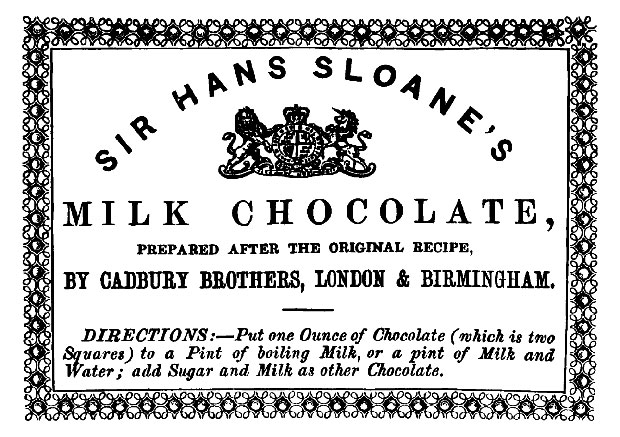
With Easter safely negotiated our thoughts can now turn away from creme eggs. According to a recent survey, the average Brit eats an average of 11.5 kgs of chocolate per year which requires the beans of 11 cacao trees. This is the equivalent of two and a half bars of Dairy Milk Chocolate per week per person – doesn’t sound too bad to me especially when Tesco has them on sale at 98p each. And it not generally known that we have to thank a local son for the introduction of chocolate in its drinking form. On further reading we discover that King Billy loved the beverage so much he designed a special chocolate kitchen in Hampton Court Palace where his manservant prepared, with the addition of spices, a morning cup of luxurious deliciousness for His Majesty. Was he the original Chocolate Orange?
Sir Hans Sloane, 1st Baronet PRS FRS, born in Killyleagh, was an Anglo–Irish physician, naturalist and collector. After studying medicine at Paris and Montpellier he graduated MD in 1683. He was elected to the Royal Society at the age of 24 and was president from 1727 to 1741. Sloane travelled to the Caribbean in 1687 and documented his travels and findings with extensive publications years later. He was a renowned medical doctor among the aristocracy and royalty, attending King George I, who made him a baronet. He was elected to the Royal College of Physicians at age 27. Streets and places have been named after him, including Hans Place, Hans Crescent, and Sloane Square, in the Chelsea area, London – the area of his final residence – and also Sir Hans Sloane Square in Killyleagh, County Down.
His motley collection of 71,000 items that had become so extensive he had to rent the house next door to accommodate them, were bequeathed to the British nation, and provided the foundation of the British Museum, the British Library and the Natural History Museum, London. Charity work included working for free at Christ’s Hospital, operating a free surgery and dispensing inexpensive medications to the poor. He was also a founding governor of the Foundling Hospital for abandoned children and encouraged inoculation against smallpox using it on his family and encouraging the royal family to take it up. Marriage to the widow Elizabeth Langley Rose, a sugar plantation heiress, meant he became a slave owner and following recent protests against historical slavery connections, a bust of Sloane was moved from its original position in August 2020 at the British Museum.
As physician to Christopher Monck, 2nd Duke of Albemarle, Governor of Jamaica, Hans toured the island looking for botanical specimens to use in his treatment of the sick. He found the locals drinking Theobroma cacao beans mixed with water but found the brew disgusting. Theobroma cacao means ‘food of the gods’ in Latin, and cacao is derived from the Nahuatl (Aztec language) word xocolatl, from xococ meaning bitter water.

Historically, unfermented cocoa seeds and the seed coat were used to treat a variety of ailments including diabetes, digestive and chest complaints. Hans conducted experiments of his own and found that by adding milk and sugar it was more palatable as a medicinal compound and, as Lily the Pink might have said, “most efficacious in every case”. Who hasn’t felt better after a Kit Kat break, or a duty free multipack of Toblerone? And it is well known that a Mars a day helps you work, rest and play. It’s worth every visit to the dentist. Sloane’s recipe was taken up by Cadbury Brothers in the 19th century,and they devised the milk chocolate bar that has been a national favourite ever since, although some say that rival chocolate manufacturer, Fry’s, actually introduced the first bar in the UK. Five Boys anyone?
So thanks to local lad Sir Hans, the good news is that now Lent is over you can safely eat or drink chocolate without feeling guilty. It started off as a medicine, so must be doing you good, and, originating from a bean, can be counted as a vegetable, thus one of your five a day.
